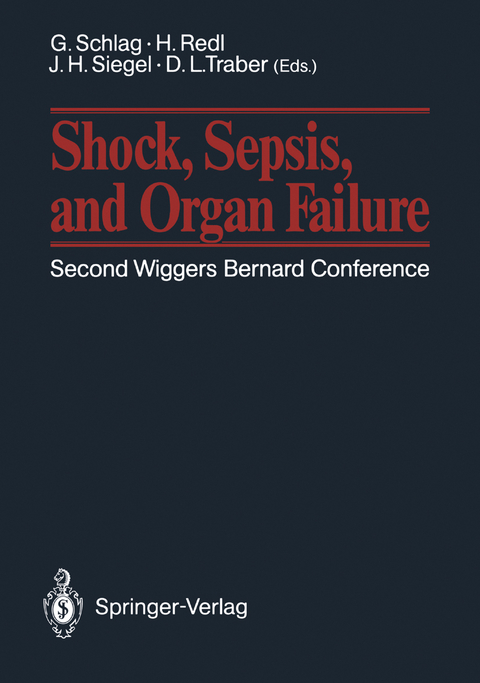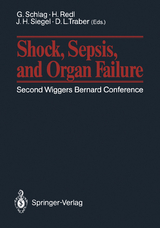Shock, Sepsis, and Organ Failure
Springer Berlin (Verlag)
978-3-540-53831-8 (ISBN)
The Wiggers Bernard Conferences, named after two great physiologists of the past, are an nual gatherings of the leaders in the field of shock. The meetings focus on specific areas of which appears to be showing the most advancement during the previous year. There are se veral types of sessions; informal presentations during which the seminarian can be intenup ted in order to clarify a particular point; formal discussions follow each presentation; these are followed by informal gatherings in which these discussions continue during meals and libation in a very relaxed environment. The 1990 meeting took place in Durnstein, Austria. A small hamlet in the wine growing area of the Wachau valley, on the Danube above Vien na. This was the site of a former citadel where the English King Richard the Lion-Heart (Coeur de Uon) was held for ransom during the middle ages. The frank beauty and hospi tality of this area in addition to the ancient Roman adage "in vino veritas" acted as a catalyst to crystalize the thoughts of this interdisciplinary group of scientists as they discussed the following areas: 1. Gut as a Source of Organ Failure 2. Metabolic Aspects of the Liver in Sepsis 3. Endothelium as a Target'in Sepsis We would like to thank the participants of the conference for taking time away from their very productive and busy schedules to participate in the conference and for the prompt pre sentation of their manuscripts and editions of their discussions.
Gut as a Source of Organ Failure.- Hypoxic Damage of the Gut in Shock.- Experimental Evidence of Bacterial Translocation in Trauma.- Bacterial Translocation in a Baboon Model of Hypovolemic-Traumatic Shock.- Bacterial Translocation Across a Histologically Intact Intestinal Mucosa.- Clinical Evidence of Bacterial Translocation from the Gut.- Role of Bacterial Translocation and Selective Gut Decontamination in the Development of Multiple Organ Failure.- Metabolic Aspects of the Liver in Sepsis.- The Liver as Modulator of the Host-Defense Response: Host-Defense Failure Disease as a Manifestation of Hepatic Decompensation.- Concepts of Liver Protein Metabolism in Sepsis.- Increased Glucose Uptake and Superoxide Anion Production After Priming of Activation of Hepatic Phagocytes: A Potential Source of Liver Damage.- Modulation of Hepatic Function in Endotoxemia by Intercellular Communication.- Endothelium as a Target in Sepsis.- Cytokine-Dependent Interleukin-8 Expression and its Role in Cell Communication.- Trauma and Sepsis Induced Activation of Granulocytes, Monocytes/Macrophages and Endothelial Cells in Primates.- Molecular Mechanisms of Neutrophil-Mediated Pulmonary Microvascular Injury: Role of Adhesion Proteins.- Pathogenetic Linkages Between Gram Negative Septic Shock and the Cellular Initiation and Regulation of Coagulation.- Sepsis, Disseminated Intravascular Coagulation and Multiorgan Failure: Catastrophic Events in Severe Burns.- Mechanisms of Vascular Impairment During Endotoxaemia with Special Reference to the Role of the L-arginine Pathway.- Permeability Changes During Experimental Endotoxemia and Sepsis.
| Erscheint lt. Verlag | 17.5.1991 |
|---|---|
| Zusatzinfo | X, 457 p. |
| Verlagsort | Berlin |
| Sprache | englisch |
| Maße | 170 x 242 mm |
| Gewicht | 786 g |
| Themenwelt | Medizin / Pharmazie ► Medizinische Fachgebiete ► Notfallmedizin |
| Studium ► Querschnittsbereiche ► Infektiologie / Immunologie | |
| Schlagworte | Bacteria • Infectious Diseases • Metabolism • Metabolismus_(Biol.) • Microbiology • Mikrobiologie • Organ Failure • Organversagen • Pathophysiologie • pathophysiology • Sepsis • Trauma |
| ISBN-10 | 3-540-53831-3 / 3540538313 |
| ISBN-13 | 978-3-540-53831-8 / 9783540538318 |
| Zustand | Neuware |
| Haben Sie eine Frage zum Produkt? |
aus dem Bereich




